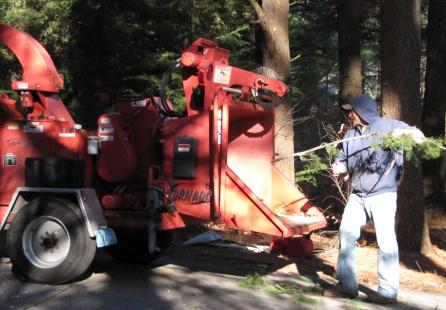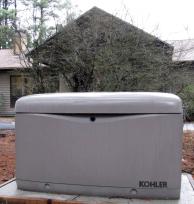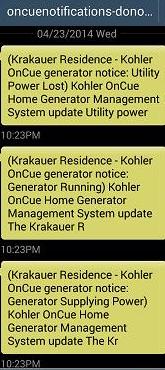
I concluded that entry by noting, "A neighbor walking his dog thanked me for preventing power failures on the lane. He figured that since I'd spent a lot of money on a generator, there wouldn't be any power failures for at least a few years". The generator was installed on November 1, 2013. A rather severe winter followed. Boston received a total of 143 cm. of snow (56.4 inches), over 60% more than usual. Snow is the usual cause of power outages in this area, combined with another ingredient: trees. Loss of electrical power is usually caused by a tree heavily loaded with snow toppling onto a power line. This is particularly frequent when strong winds are added to the mix. In the Blizzard of 1978, described in my blog entry entitled Boston, we lost electrical power for five days. Damage to the power distribution system was so extensive that most of the wiring had to be entirely rebuilt. As is common in such cases, the power company brought in help from distant communities. The workers who rebuilt the wiring on our street turned out to have come all the way from Québec, Canada. Note 1 In the Blizzard of 2013, in February of 2013 (so one winter ago), we were lucky enough to not lose electricity at all. But in the winter that just ended, the winter of 2013–2014, as storm after storm hit, we kept hoping for our electricity to go out. Why would we want to lose power? Well, we had just spent a fairly considerable amount of money installing a backup generator. If years were to go by without an outage, in some sense the money spent on the generator would have been wasted. Although the generator had been used to power the house for two hours during its acceptance test, we wanted to see a real-world use of the generator, to know that our expenditure had not been in vain. But storm after storm after storm, our electricity remained. Looking out the window, we watched snow-laden trees swaying in high winds, but time after time, our electricity remained uninterrupted. Every Friday at 10:38 Eastern Standard Time the generator dutifully started up and ran 20 minutes of diagnostic testing. This tests the engine to be sure it's still operative, but no electricity is generated. Spring came, and we figured we wouldn't have any occasion to use the generator until the next winter (although in past years we have occasionally had snowfalls in April, and even as late as early May). Then came Wednesday, April 23. It was a rather windy day, but hardly a hurricane. There was no rain, and no snow. Yet at 10:23 in the evening, Eastern Daylight Time, the house suddenly went dark. I called out to Margie, "Wait for it!" And sure enough, eight seconds later, with a loud "Clunk" from the Transfer Switch in the basement, the lights all came back on exactly as they had been before. The only difference was the faint sound of the generator running in a small wooded area in front of our house. I said to Margie, "We're on generator." I was happy to see the system pass its first real-world test with flying colors.
You can see to the right that the generator reported first "Utility Power Lost", followed by "Generator Running", and finally "Generator Supplying Power" (I have no idea why Kohler thinks these need to be reported with capitalized words). The title at the top, "oncuenotifications", refers to the name of this generator option, which is called the "OnCue" system. I looked outside to verify that power was also out at the houses across the street, in addition to my house. I then telephoned the power company, NStar, and reported the outage using their automated outage reporting system. Within 15 minutes or so, I saw the lights of a large truck in front of our neighbors to the north. I walked down the lane to see what was going on, taking care to watch out for any fallen wires. The cause of the problem was obvious. A large tree lay across Orchard Lane, blocking it entirely. One end was on the ground, and the other end was hanging on the electrical wires, which had been partially pulled off their poles. The first wire it had hit upon falling was a 7,900 Volt high-tension line. Shorting this to ground had of course opened a circuit breaker, cutting off the entire lane. I spoke to the driver of the truck, who turned out to be from the Wayland Fire Department. He was there to be sure nobody got into any trouble due to the downed tree, and he told me he would stay there until NStar arrived to make repairs. A look shortly thereafter at NStar's webpage showed Wayland to have 25 houses without power. That's approximately the number of houses on our dead-end lane. We then went about our evening as if nothing had happened. We watched television, and Margie used her computer as usual (mine was out being virus-scanned). We went to bed at our usual hour. The house remained pleasantly warm, we could use any electrical lights we desired, and the contents of our refrigerator and freezer were safe. In the morning, I checked my phone to find the messages seen to the left. The power had come back on at 4:02 AM, and after waiting a couple of minutes for it to stabilize, the Transfer Switch had switched the house back to utility power as we slept, after which the generator had shut down. It had supplied the house with power for five hours and 41 minutes in its first actual use. Before the generator, losing electricity wasn't the end of the world. If it was cold outside, the house started to get clammy and uncomfortable after a few hours, as the heating system can't operate without power. We would lose our television reception, and living at night by the light of flashlights was rather annoying. When our computers went down years ago we used to lose our Internet connection, including e-mail, but with the advent of smart phones, we could maintain internet access and e-mail even without a generator. If an outage lasted more than a day, we would lose the contents of our freezer and refrigerator, unless the outside weather was consistently below freezing. In that case, we would transfer the contents to coolers left outdoors. But these are limited in capacity, and food can't be simply left outdoors unprotected, or it will be broken into by animals. But this time, the generator made the experience of a power failure much more pleasant. We were really not inconvenienced in the slightest. Margie in particular appreciates this, even though this particular outage wasn't long enough to have been a major inconvenience even had we not had the generator. I didn't get a picture of the tree lying across the road in the dark. It would have taken a time exposure to capture it. But below to the left is what the tree looked like the next morning. You can see that it broke not at the base, but rather a point quite high off the ground. I imagine there must've been some sort of defect there (you can click on the picture to greatly enlarge it). Below to the right, a town of Wayland employee uses a large "chipper" to remove the remains of the tree. With all the trees in town, Wayland has a lot of use for this device. By the time I got out to take this picture, he was down to the smaller branches, but the chipper was able to handle branches that were much larger.   If that's the only power failure we have, then the cost of that approximately 5½ hours of electricity was awfully high. But if there's a second failure, our cost per outage will be cut in half. We'll see what happens over the next few years. Added note: It only took about two months until the next failure, as described in Power failure (bis). Then I've continued to track all subsequent power failures in a table at the bottom of that entry.   Note 1: I talked to one of the electrical workers from Québec while he took a lunch break. He thought we were crazy to allow so many trees close to our wiring. He said that in Québec, any trees within 15 to 20 meters (about 50 to 65 feet) of a power line would be cut down. Of course, in a fairly densely populated suburb like Wayland, a significant percentage of our trees would be lost. And we do love our trees. Years ago, a proposal was presented to the Wayland open Town Meeting (the town's legislature) to require a new tree to be planted any time a tree within 25 feet of a road was cut down. This proposal was made by Shirley Barnes, who at the time spoke often at Town Meetings. In accordance with custom, she started her remarks with, "Mr. Moderator, Shirley Barnes, Loblolly Lane". Walter Pope, who I think was a Selectman at the time, spoke against the proposal. He said, "Mr. Moderator, we have no shortage of trees in Wayland. How can I put this? In Wayland, we cut down trees with our lawnmowers." It passed anyway. [return to text]
 |


